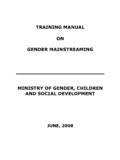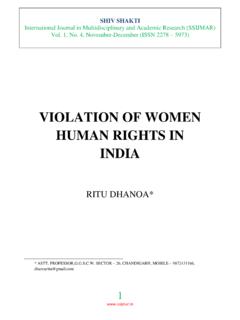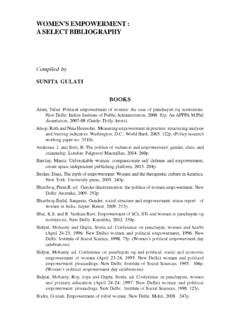Transcription of REPORT OF THE FEDERAL DEMOCRATIC REPUBLIC …
1 REPORT OF THE FEDERAL DEMOCRATIC REPUBLIC OF ethiopia ON THE IMPLEMENTATION OF THE AU SOLEMN DECLARATION ON gender equality IN AFRICA AUGUST 2006 2 Acronyms ACRWC African Charter on the Rights and Welfare of the Child BPAC Beijing Platform for Action CEDAW Convention on the Elimination of All Forms of Discrimination against Women CRC Convention on the Rights of the Child CSA Central Statistical Authority EPA Environmental Protection Authority ESDP Education Sector Development Program FDRE FEDERAL DEMOCRATIC REPUBLIC of ethiopia FGM Female Genital Mutilation HEP Health Extension Program HIV/AIDS Human Immunodeficiency Virus/ Acquired Immunodeficiency Syndrome HSDP Health Sector Development Program HTP Harmful Traditional Practice IOM International Organization for Migration MDG Millennium Development Goal MOLSA Ministry of Labor and Social Affairs MOWA Ministry of Women s Affairs NCTPE National Committee on Traditional Practice of ethiopia RBM Roll Back Malaria TB Tuberculosis TVET Technical and Vocational Education and Training 3 INTRODUCTION Like many African countries, the majority of women in ethiopia hold low status in the society.
2 They have been denied equal access to education, training and gainful employment opportunities and their involvement in policy formulation and decision-making processes has been minimal. Women play a vital role in the community by taking care of all social activities. However, they do not enjoy the fruits of their labor and suffer from political, economical, social and cultural marginalization. Although women constitute of the population and contribute their share in agricultural production and other household activities, they have not benefited from their labor equally with their male counterparts. The participation of women in qualified jobs and related fields is at its lowest level. For instance, the National Labor Force Survey (CSA, 1999) indicates that women account for only in technical and professional fields. The majority of women perform tiresome, low paid and even unpaid jobs.
3 The 1994 census on employment also shows that women represent only of the total government employees and of them are engaged in low-grade jobs. The Government of the FEDERAL DEMOCRATIC REPUBLIC of ethiopia (FDRE) formulated several laws and policies to promote gender equality . Particularly Article 35 of the Constitution of the FEDERAL DEMOCRATIC REPUBLIC of ethiopia clearly stipulates the rights of women. The government has also been promoting the mainstreaming of gender in all its development policies and strategies to address gender inequality. Women s National Policy was formulated and adopted in 1993 in order to address gender inequality. National institutional machineries were established at FEDERAL , regional and Woreda (district) levels to implement the policy. The Women s Affairs Office has been reestablished as a full-fledged Ministry in October 2005 with the duties and responsibilities of ensuring participation and empowerment of women in political, economical, social and cultural matters.
4 The Labor proclamation No 42/93 as well as the newly amended labor law 377/2004 stipulates that women shall not be discriminated against employment and equal payment on the basis of their sex. It also prohibits employment of women on a type of work that may be harmful to their health. The criminal code/penal code has been recently revised and amended to address discrimination against women and protect them from criminal acts such as rape, abduction, Female Genital Mutilation (FGM), sexual exploitation and harassment ..etc. The Criminal procedural code has also been revised 4 and the first draft has been submitted to the Council of Ministers. The document is forwarded to the parliament for further comment and approval. The 1997 FEDERAL Rural Land Administration Law has provisions on equal rights of women to land.
5 The FEDERAL Government and 3 Regional States have enacted Land Use and Administration Laws that took into account the issue of gender . Proclamation that established the Environmental Protection Authority (EPA) also ensures women's environmental rights. The Civil Service proclamation provides equal employment opportunity for both sexes. Moreover, efforts have been made to address the problem of gender inequality and gender based discrimination in the Education and training policy. Economic Reform policy that was formulated in 1992 also aims to promote economic development and improve the living standard of the most vulnerable sections of the society, particularly women. The economic policy ensured equal rights of agricultural land use, control and participation of women in extension services. The Health Policy, Developmental Social Welfare Policy, Cultural Policy, the Policy on Natural Resources and the Environment, the Civil Service Proclamation, Pension Law, Penal aim to improve the livelihood of women.
6 HIV/ AIDS and Other Related Infectious Diseases There are basic supportive legal grounds conducive for combating the HIV/AIDS pandemic and other related infectious diseases, among which, the following are the major ones. Article 34 (4) and article 35 (9) of the Constitution provide the right to health care and the right to protection from harmful customs and practices. Moreover, Article 35 (7) of the Constitution provides equal rights for women with regard to inheritance and property rights. On the other hand, article 514 of the Penal Code makes any deliberate or negligent act to transmit any kind of disease to a person punishable by law. Efforts are underway to enact specific law for HIV/AIDS. The legal provisions regarding gender -based violence are specified in the gender based violence section. However, there are many challenges with regard to implementation because of lack of awareness and other social barriers.
7 There is also a problem of capacity in the judiciary. The hope is that the Justice Sector Reform Program currently underway will help resolve this problem. There are a number of measures being undertaken to improve the health conditions of the society in general and that of women in particular. There are 5 commitments made at international, regional as well as national levels to meet the Millennium Development Goals (MDGS) on health. The government of ethiopia designs and implements the Health Sector Development Plan (HSDP) every five-years and the third HSDP (2005/6-2010/11) is currently under implementation. Among other components of the HSDP, the Health Extension Program (HEP) aims to effectively address primary health care by focusing on prevention through community participation.
8 Infectious and communicable diseases account for 60-80% of all diseases in the country. Therefore, to speed up the implementation of HSDP and achieve the health coverage target, training of health agents is being conducted. These health agents in turn will train women extension workers. The major responsibility of health extension agents is to teach and engage the community through door to door visits and teach them about preventable diseases including HIV/AIDS. A policy on HIV/AIDS was formulated and the major focuses of the strategic plan, which has been prepared for the implementation of the policy include: 1) Building the capacity of key sectors such as health, education and civil society organizations in terms of technical knowledge, infrastructure and systems; 2) Integrating HIV/AIDS work with health extension program; 3) Mobilizing the community; 4) Providing multi-sectoral response; 5) Giving special focus to vulnerable groups (youth, sex-workers, mobile workers, the army and teachers); 6) Involving of the leaders in the planning and implementation process.
9 The National Council of HIV/AIDS whose members are drawn from governmental, non-governmental, religious and community elders is entrusted with the task of monitoring the implementation of the policy, whereas HIV/AIDS prevention and control offices established at each administrative region are responsible for day-to-day activities. Efforts are underway to expand health facilities in order to render effective health services. According to Health and Health Related Indicators produced by the Ministry of Health, in the last five years the number of health centers, health posts and private clinics has increased from 382 - 600, 1,023 - 4,211 and 1578 1170, respectively. In the 2005/06 REPORT of the HIV/AIDS Prevention and Control Office, it is indicated that volunteer counseling and testing service was provided in 658 health institutions but the number of beneficiaries was only 229,850(female) and 221,537(male) in 2004/05.
10 6 HIV/AIDS treatment services were provided in 73 health institutions and about 94% are treated free of charge, of which the majority are female. These notwithstanding, however, there are a number of cultural and socio- economic barriers including poverty, unemployment, expansion of prostitution, illiteracy, migration, HTP, According to the Fifth REPORT on HIV/ AIDS (2004) issued by the Ministry of Health, the total prevalence rate is %. Out of this figure, 54% are female of which 96,000 are less than 15 years of age. The estimated number of orphans who lost their parents due to HIV/AIDS is about 537,000. Malaria prevention and treatment mechanisms are in place in line with the National Strategic Plan for Control of Malaria in ethiopia , which is prepared based on the framework of the WHO Global Roll Back Malaria (RBM) Strategy.





